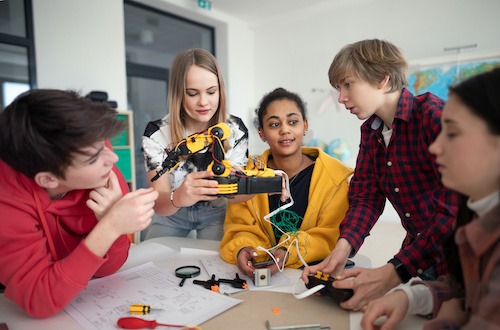
Introduction to technology in education
In today’s fast-paced world, technology is reshaping every aspect of our lives, and education is no exception. Gone are the days when learning revolved solely around textbooks and chalkboards. With a plethora of digital tools at our fingertips, classrooms have transformed into interactive hubs of knowledge. Students can now explore subjects in ways that were once unimaginable, sparking curiosity and creativity like never before.
Imagine a classroom where virtual reality transports students to ancient civilizations or coding apps turn programming concepts into engaging games. This shift isn’t just about gadgets; it’s about revolutionizing how we learn and teach. Technology is breaking down barriers to education by making information accessible anytime, anywhere, fostering an environment rich with collaboration and discovery.
As we delve deeper into this topic, let’s uncover the myriad benefits that technology brings to learning environments across the globe!
Benefits of using technology in learning
Technology in learning opens doors to endless resources. Students gain access to a wealth of information at their fingertips. This availability encourages independent research and fosters critical thinking.
Personalized learning is another significant advantage. Adaptive software tailors lessons to meet individual needs, allowing students to progress at their own pace. This customization enhances understanding and retention.
Collaboration becomes effortless through digital tools. Online platforms facilitate communication among peers, enabling group projects that transcend geographical boundaries. Such interactions prepare students for real-world teamwork.
Moreover, technology caters to diverse learning styles. Visual learners benefit from videos and interactive simulations, while auditory learners thrive with podcasts and audiobooks.
Engagement levels increase as gamification makes education fun. Game-based elements keep students motivated while reinforcing concepts in an enjoyable way. The result? A more dynamic educational experience that resonates with today’s tech-savvy youth.

Examples of innovative technology in classrooms
Classrooms today are transforming with innovative technologies that enhance the learning experience. One exciting example is virtual reality (VR). It allows students to immerse themselves in different environments, from historical sites to outer space.
Another groundbreaking tool is interactive whiteboards. These dynamic devices facilitate engaging lessons by enabling teachers and students to collaborate in real-time. They can display multimedia content, making complex concepts easier to grasp.
Learning management systems (LMS) have also gained traction. They provide a centralized platform for course materials, assignments, and communication between educators and learners. With these systems, education becomes more organized and accessible.
Gamification is yet another trend reshaping classrooms. By incorporating game-like elements into learning activities, teachers can motivate students through challenges and rewards. This approach not only makes learning fun but also encourages teamwork and critical thinking skills.
These examples illustrate how technology continues revolutionizing learning environments every day.
Digital vs Traditional Learning Methods
Digital learning methods have transformed the educational landscape. With online courses, interactive apps, and virtual classrooms, students can access information anytime and anywhere. This flexibility empowers learners to take control of their education.
On the other hand, traditional learning relies heavily on face-to-face interactions. It fosters community through group discussions and hands-on experiences with teachers guiding lessons in real-time. Many find this setting beneficial for building relationships.
However, digital platforms often provide personalized learning paths. Adaptive technologies cater to individual student needs more effectively than a one-size-fits-all approach typical in traditional environments.
Yet, some argue that the lack of physical presence in digital settings can lead to isolation. The social aspect of learning is essential for many students’ growth and motivation.
Both methods have strengths and weaknesses that educators must consider when designing effective curricula for today’s diverse learners.

The impact of technology on student engagement and motivation
Technology has transformed the way students interact with content. Digital tools create dynamic learning environments that are often more engaging than traditional methods.
Interactive platforms, such as educational apps and online games, invite participation rather than passive observation. This shift encourages students to take an active role in their education.
Moreover, technology caters to diverse learning styles. Visual learners can benefit from videos and graphics, while auditory learners thrive with podcasts and discussions.
The instant feedback provided by digital assessments boosts motivation too. Students appreciate knowing where they stand and what areas need improvement.
Additionally, collaboration becomes easier through shared online spaces. Group projects can happen seamlessly across distances, enhancing teamwork skills along with engagement levels.
As a result of these innovations, many students find themselves more motivated to learn than ever before.
Challenges and concerns with implementing technology in education
While technology is reshaping the educational landscape, it comes with its own set of challenges. One significant concern is the digital divide. Not every student has equal access to devices or reliable internet, creating disparities in learning opportunities.
Moreover, teacher training remains a hurdle. Many educators feel unprepared to integrate new technologies effectively into their curriculums. Without proper guidance and resources, potential benefits may go unrealized.
There’s also the issue of screen fatigue among students. Constant exposure to screens can lead to decreased attention spans and burnout.
Privacy concerns cannot be overlooked either. The collection of student data raises questions about security and consent.
Balancing innovation with these challenges requires careful consideration from schools and policymakers alike.
The future of learning with advancements in technology
The future of learning is set to be a thrilling journey, driven by relentless advancements in technology. Imagine classrooms where virtual and augmented reality bring subjects like history and science to life. Students can explore ancient civilizations or dive into the human body without leaving their seats.
Artificial intelligence will play a pivotal role too. Personalized learning paths tailored to individual student needs could become the norm, allowing everyone to learn at their own pace.
Moreover, collaborative tools will foster global partnerships among students, breaking geographical barriers. They’ll team up on projects with peers from different countries, gaining cultural insights that enrich their education.
As we embrace these changes, educators will evolve as facilitators rather than mere transmitters of knowledge. This transformation promises not just smarter students but also more engaged citizens equipped for an ever-changing world. The possibilities are truly limitless!
Conclusion
The landscape of education is changing rapidly, driven by the power of technology. As tools like interactive whiteboards and virtual reality become commonplace in classrooms, they open doors to new possibilities for learning experiences. These advancements not only make lessons more engaging but also cater to various learning styles.
Technology enhances accessibility as well, breaking down barriers that once impeded students from accessing quality education. With online resources and platforms available at their fingertips, learners can explore topics deeply or revisit concepts at their own pace.
However, it’s essential to recognize that implementing such innovations comes with challenges. Schools must ensure equitable access to devices and internet connectivity while providing adequate training for educators to integrate these tools effectively into their teaching methods.
Looking ahead, the future of learning promises even greater transformations. Innovations like artificial intelligence will likely personalize education further, adapting curricula based on individual student needs and performance metrics.
As we navigate this exciting journey through educational transformation led by technology, the potential for improved engagement and motivation among students stands out as a beacon of hope for educators worldwide. The revolutionizing effect technology has on learning continues to unfold before us—inviting curiosity about what lies ahead in our quest for knowledge.



Leave a Reply